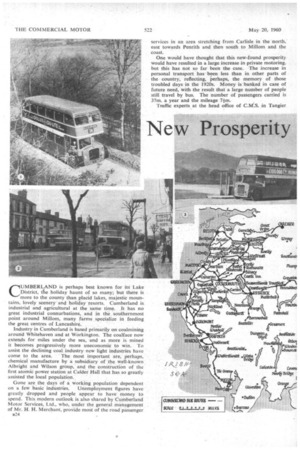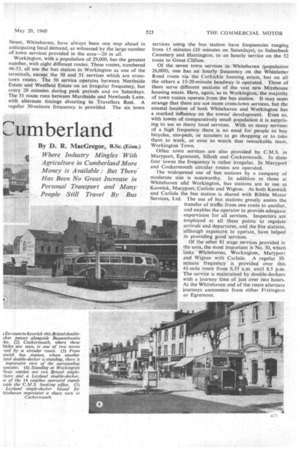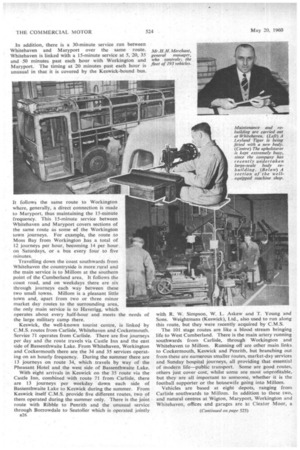New Prosperity Cumberland
Page 58

Page 59

Page 60

Page 63

If you've noticed an error in this article please click here to report it so we can fix it.
CUMBERLAND is perhaps best known for its Lake District, tte holiday haunt of so many; but there is more to the county than placid lakes, majestic mountains, lovely scenery and holiday resorts. Cumberland is industrial and agricultural at the same time. It has no great industrial connurbations, and in the southernmost point around Millom, many farms specialize in feeding
the great centres of Lancashire., , .
Industry in Cumberland is based primarily on coalmining around Whitehaven and at Workington. The coalface now extends for miles under the sea, and as more is mined it becomes progressively more uneconomic to win. To assist the declining coal industry new light industries have come to the area. . The most important are, perhaps, chemical manufacture by a subsidiary of the well-known Albright and Wilson group, and the construction of the first atomic power station at Calder Hall that has so greatly assisted the local population.
Gone are the days of a. working population dependent
on a few basic industries. Unemployment figures have greatly dropped and people appear to have money to spend. This modern outlook is also shared by Cumberland Motor Services, Ltd., who, under the general management of Mr. H. H. Merchant, provide most of the road passenger B24 services in an area stretching from Carlisle in the north, east towards Penrith and then south to Millom and the coast.
One would have thought that this new-found prosperity would have resulted in a large increase in private motoring, but this has not so far been the case. The increase in personal transport has been less than in other parts of the country, reflecting, perhaps, the memory of those troubled days in the 1920s. Money is banked in case of future need, with the result that a large number of people still travel by bus. The number of passengers carried is 37m. a year and the mileage 71m.
Traffic experts at the head office of C.M.S. in Tangier Street, Whitehaven, have always been one step ahead in anticipating local demand, as witnessed by the large number of town services provided in the area-20 in all.
Workington, with a population of 29,000, has the greatest number, with eight different routes. These routes, numbered 46-53, all use the bus station in Workington as one of the terminals, except the 50 and 51 services which are crosstown routes. The 50 service operates between Northside Estate and Westfield Estate on an irregular frequency, but every 20 minutes during peak periods and on Saturdays. The 51 route runs between Marshside and Newlands Lane, with alternate timings diverting to Travellers Rest. A regular 30-minute frequency is provided. The six town
services "using -the bus station . have frequencies ranging from 15 minutes (10 minutes on Saturdays), to Salterbeck Cemetery. and Harrington, to an hourly serviee on the 52 route to Great Clifton.
Of the seven town services in Whitehaven (population 26,000), one has an hourlyfrequency on the Whinlatter Road route. via the Corkickle housing estate, but on all the others a 15-20-minute headway is operated. Three of them serve different sections of the vast new Mirehouse housing estate. Here, again, as in Workington, the majority of town routes operate from the bus station. It may seem strange that there are not more cross-town services, but the coastal location of both Whitehaven and Workington has a marked influence on the towns' development. Even so, with towns of comparatively small population it is surprising to see so many local services. With so many services of a high frequency there is no need for people to buy bicycles, mo-peds, or scooters to go shopping or to take them to work, or even to watch that remarkable team, Workington Town.
Other town services are also provided by C.M.S. in Maryport, Egremont, Silloth and Cockermouth. In these four towns the frequency is rather irregular. In Maryport and Cockermouth circular routes are operated.
The widespread use of bus stations by a company of moderate size is noteworthy. In addition to those a: Whitehaven afid Workington, bus stations are in use at Keswick, Maryport, Carlisle and Wigton. At both Keswick and Carlisle the bus station is shared with Ribble Motor Services, Ltd. The use of bus stations greatly assists the transfer of traffic from one route to another, and enables the operator to provide adequate supervision for all services. Inspectors are employed at all these points to regulate arrivals and departures, and the five stations, although expensive to operate, have helped in providing good services.
Of the other 81 stage services provided in the area, tlw most important is No. 30, which links Whitehaven, Workington,' Maryport and Wigton with Carlisle. A regular 30minute frequency is provided over this 41-mile route from 6.35 a.m.. until 8.5 p.m. The service is maintained by double-deckers with a journey. time of just over two hours. At the Whitehaven end of the route alternate journeys commence from either Frizington or Egremont. In addition, there is a 30-minute service run between Whitehaven and Maryport over the same route. Whitehaven is linked with a 15-minute service at 5, 20, 35 and 50 minutes past each hour with Workington and Maryport. The timing at 20 minutes past each hour is unusual in that it is covered by the Keswick-bound bus.
It follows the same route to Workington where, generally, a direct connection is made to Maryport, thus maintaining the 15-minute frequency. This 15-minute service between Whitehaven and Maryport covers sections of the same route as some of the Workington town journeys. For example, the route to Moss Bay from Workington has a total of
12 journeys per hour, becoming 14 per hour on Saturdays, or a bus every four to five minutes.
Travelling down the coast southwards from Whitehaven the countryside is more rural and the main service is to Millom at the southern point of the Cumberland area. It follows the coast road, and on weekdays there are six through journeys each way between these two small towns. Millom is a pleasant little town and, apart from two or three minor market day routes to the surrounding area, the only main service is to Haverigg, which operates about every half-hour and meets the needs of the large military camp there.
Keswick, the well-known tourist centre, is linked by C.M.S. routes from Carlisle, Whitehaven and Cockermouth. Service 71 operates from Carlisle. There are five journeys per day and the route travels via Castle Inn and the east side of Bassenthwaite Lake. From Whitehaven, Workington and Cockermouth there are the 34 and 35 services operating on an hourly frequency. During the summer there are 13 journeys on route 34, which travels by way of the Pheasant Hotel and the west side of Basserithwaite Lake.
With eight arrivals in Keswick on the 35 route via the Castle Inn, combined with route 71 from Carlisle, there are 13 journeys per weekday down each side of Bassenthwaite Lake to Keswick during the summer. From Keswick itself C.M.S. provide five different routes, two of them operated during the summer only. There is the joint route with Ribble to Penrith and the unusual service through Borrowdale to Seatoller which is operated jointly with R. W. Simpson, W. L. Askew and T. Young and Sons. Weightmans (Keswick), Ltd., also used to run along this route, but they were recently acquired by C.M.S.
The 101 stage routes are like a blood stream bringing life to West Cumberland. There is the main artery running southwards from Carlisle, through Workington and Whitehaven to Millom. Running off are other main links to Cockermouth, Keswick and Penrith, but branching out from these are numerous smaller routes, market-day services and Sunday hospital journeys, all providing that essential of modern life—public transport. Some are good routes, others just cover cost, whilst some are most unprofitable, but they are all important to someone, whether it is the football supporter or the housewife going into Millom.
Vehicles are based at eight depots, ranging from Carlisle southwards to Millom. in addition to these two, and natural centres at Wigton, Maryport, Workington and Whitehaven, offices and garages are at Cleator Moor, a short distance from Whitehaven, Cockermouth and Keswick. Only a small number of coaches is garaged at Carlisle, all double-deckers for stage routes being housed at Wigton.
C.M.S. operate a fleet of 193 vehicles compos'ed of 131 double-deckers, 48 single-deckers and 14 coaches. There are 91 double-deckers, 43 single-deckers and 3 coaches of Leyland make and 40 double-deckers, 5 single-deckers and 11 coaches by Bristol. Bodywork is by Massey, Associated Coach Builders, N.C.B., Leyland, E.C.W. and. Burlingham.
It may seem strange that in a Tilling-controlled company there should be such a high number of modern Leyland buses, as opposed to 'Bristol vehicles.
Bristol vehicles with E.W.C. coachwork, as standardized by Tilling-controlled companies, were not introduced until late 1954; since then all deliveries have been of this make. The 137 Leylands are mainly PSI and PD! and PD2 machines, but there are also 15 Royal Tiger single-deckers, five with E.C.W. 45-seat bus bodies, seven with Leyland bus bodies and three with Leyland coach bodies seating 41 passengers.
Old Policy Retained Cumberland Motor Services, although in the B.A.T.-Tilling empire, were more closely allied to B.A.T. policy. Although they were allocated to Tillings in the 1942 separation, they operated no Bristol vehicles at that time. if they had been introduced in 1946, when all Tilling companies were running Bristol machines, it would have meant an entirely different type of chassis in the fleet, with associated problems of spares and service. Furthermore, the demand for Bristol coaches was far in excess of supply, so C.M.S. were allowed to carry on with their old policy of buying Leylands.
Maintenance is undertaken in the main overhaul shop at Whitehaven. In addition to the normal maintenance and docking schedules, the company have been rebuilding and rebodying vehicles on a large seale during recent months. Leyland bodies on PDI chassis have been extensively rebuilt, whilst PSI Tigers which originally had A.C.B. bodies have been rebodied by either E.C.W. or C.M.S.
Two Lodeldia Types The hilly nature of many of the routes has made it necessary for the chief engineer, Mr. P. A. Robinson, to specify two types of Bristol Lodekka vehicle. Some have four-speed gearboxes and low-ratio differentials for town routes, whilst ethers with five-speed gearboxes and highratio differentials are employed on 'country routes.
The maintenance department have been experimenting with interior heating systems. Cumberland is exposed to the cold winds blowing in from the Irish sea, and to make winter travel a little more pleasant, early experiments were made with the Cave-Brown-Cave system of heating on a Bristol.
C.M.S. have always confined their activities to West Cumberland, and have refrained from expanding, as did other operators, especially in the Carlisle area. This policy has made it possible for them to consolidate their area of operation. Apart from excursion traffic, private hire is important, and works, school, church and football outings all provide a steady demand for the fleet.




















































































































